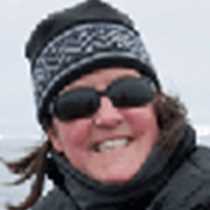At Sea
We are steadily making our way towards the wildlife paradise that is South Georgia. A walk around the decks revealed that we had picked up a stowaway, a lone South Georgia diving petrel.
Our Expedition Leader Tom Richie showed us the small bird on the sun deck as he carefully held it in his hand. We had seen these small birds swirling in the National Geographic Explorer’s wake all day so it was a fantastic opportunity to see so close up.
Diving petrels are only found in the southern hemisphere but their size and flight patterns are much more like the auks that you find in the north hemisphere. Their common name comes from their feeding behavior when they dive under the water and use their short wings to propel themselves below the surface.
The South Georgia diving petrel nests in burrows all over the island. The adults will feed at sea throughout the day and return to their burrows at night. This allows them a better chance to avoid predation by skuas and giant petrels. The adults feed on krill and small fish and then regurgitate it to their young. During our time in South Georgia we will close all the blinds and dim the outside lights in order to try not to pick up anymore bird stowaways.
Who knows what we may encounter during our day tomorrow?
We are steadily making our way towards the wildlife paradise that is South Georgia. A walk around the decks revealed that we had picked up a stowaway, a lone South Georgia diving petrel.
Our Expedition Leader Tom Richie showed us the small bird on the sun deck as he carefully held it in his hand. We had seen these small birds swirling in the National Geographic Explorer’s wake all day so it was a fantastic opportunity to see so close up.
Diving petrels are only found in the southern hemisphere but their size and flight patterns are much more like the auks that you find in the north hemisphere. Their common name comes from their feeding behavior when they dive under the water and use their short wings to propel themselves below the surface.
The South Georgia diving petrel nests in burrows all over the island. The adults will feed at sea throughout the day and return to their burrows at night. This allows them a better chance to avoid predation by skuas and giant petrels. The adults feed on krill and small fish and then regurgitate it to their young. During our time in South Georgia we will close all the blinds and dim the outside lights in order to try not to pick up anymore bird stowaways.
Who knows what we may encounter during our day tomorrow?




